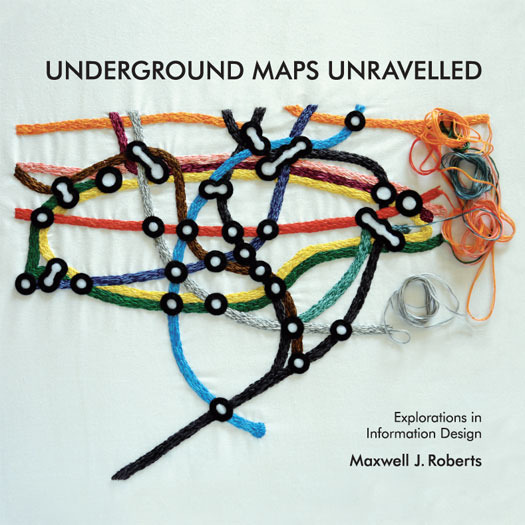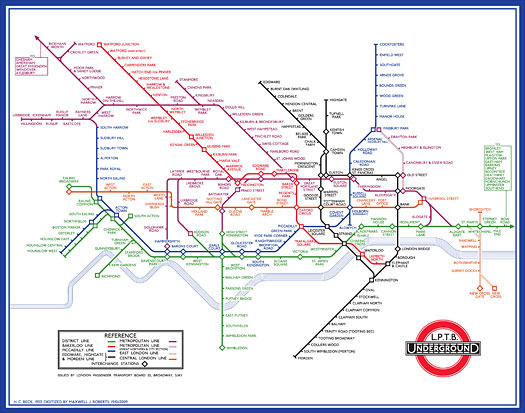
Underground Maps Unraveled: Explorations in Information Design is a weighty volume, both rich in content and high in poundage. The author, Maxwell J. Roberts, is a British psychologist who has conducted usability studies of underground rail system maps for over a decade. I also strongly suspect that he was a graphic designer in a former life. Roberts’ book provides a wealth of information that graphic designers, map aficionados, and public transport officials will find brilliant.
The book is based on the premise that schematic rail transportation maps, as epitomized by Henry Beck’s groundbreaking diagrammatic 1933 London Underground map, help users more effectively navigate transit systems by simplifying tangled routes and interchanges into a clear gestalt. This has two benefits, one functional: aiding effective trip planning, and the other promotional: increasing ridership with the appearance of clear, user-friendly transit service.
Given this basic premise, the author has set forth to systematically explore methods for improving the design of diagrammatic transport maps. Underground Maps Unravelled is organized into seven sections of three to seven chapters each. Primary topics include the history and rationale of diagrammatic transportation maps, the rules for constructing such maps, analysis of existing maps, and presentation of alternative map designs.

Henry Beck’s 1933 London Underground map.
As a signage designer, I was especially interested in the book’s early chapters on the evolution of the London Underground’s signage, maps, architecture, and publicity into a coordinated whole, thus blazing the trail for contemporary brand identity programs. This early attention to coordinated design is credited to Frank Pick, who joined the Underground's parent in 1906 as an advocate of ”fitness for purpose”, and accomplished this mission with an enduring clarity that few transport organizations achieve even today.
Using the London Underground network as his test subject, Roberts proceeds to systematically explore various schematic map designs based on various levels of linearity. He borrows from the lexicon of mathematics to define his linearity levels, which categorize the number of angled lines used to construct each map. Roberts’ linearity explorations range from a simple tetralinear construction, which uses four lines regularly spaced at 90 degree angles to each other, to more complex multi-linear construction with multiple lines spaced at irregular angles and curvilinear construction with smooth, simple Bézier curves intersecting at irregular angles.
He evaluates the results of these various linear construction methods in terms of geometric simplicity, coherence, and harmony of design. He also investigates topographic and scale distortion, and typeface and typographic placement, particularly in relation to map geometry. This all results in Roberts’ rather revolutionary conclusion that classic octolinear map construction per Henry Beck’s rules is not always the best schematic approach for mapping a given transport network.
Roberts proceeds to trace the international history of diagrammatic transportation map development, with examples from several cities. He focuses on the Madrid, Paris, and Berlin rail transit maps in some detail, and explores various new approaches for the Berlin network in particular. He even delves into the controversy created by Massimo Vignelli’s iconically schematic 1972 New York Subway map and New York’s subsequent 1979 adoption of a more topographic map, which remains essentially unchanged to this day.

Different ways of mapping the Washington DC Metro.
The first chapter of the final section puts forth principles for schematic transit map design, and states the need for objective testing of map mock-ups among users. It is followed by a chapter featuring London Underground maps developed by Roberts, in whimsical stylistic interpretations of Art Nouveau and Art Deco, to illustrate his point that the best maps are both usable and engaging.
The final chapter calls for a “periodic table” of schematic maps, based on transport network complexity correlated to increasing levels of map design linearity. This is illustrated by a fascinating series of maps the author developed for the relatively simple Washington, DC Metro network. Roberts closes on a high note, drawing similarities between Bach’s fugues and the art of design — essentially the eternal quest for balance between objectivity and subjectivity that is inherent in any serious design endeavor.
Graphic designers may find Roberts’ intricate, rigorous analysis of historical and prototypical transportation maps overly detailed, while map fans will find a treasure trove. On the other hand, graphic designers will find useful, objective principles, benchmarks, and approaches to map design throughout the book — all supported by Roberts’ meticulous research and analysis, which can facilitate collaboration by map designers and transport officials, and result in improved transit system maps.
The hardbound, full-color book is nicely printed on posh paper, with illustrations galore, many of them digitized recreations or modifications of historical printed maps. The body copy (unfortunately set in Futura) is perhaps one point too small for the dense paragraphing, and some readers may find the extensive cross-referencing of illustrations and bibliographic citations throughout the text cumbersome. However, none of these minor details detract from the substance of this weighty, groundbreaking book, which provides a seminal framework for more effective, engaging transportation map design.
